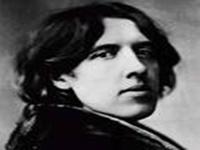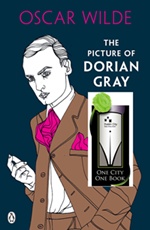Shades of Gray

Oscar Wilde’s The Picture of Dorian Gray is the 2010 Dublin: One City, One Book. As a citywide celebration of the novel begins, Politico spoke to Trinity College English Literature lecturer and Wilde expert, Dr. Jarlath Killeen about its origins, reception and the hidden sides of its author it reveals. By Edward O’Hare.
(Politico review of Dorian Gray here)
Anyone who intends to read Oscar Wilde’s The Picture of Dorian Gray, the Dublin: One City, One Book choice for 2010, is certainly in for a treat, but it may not be the kind they expect. Dorian Gray is a brief novel, you may already know its story, and it comes from the pen of a famous author whose work many of us feel familiar and comfortable with. But admirers of Wilde’s society plays should prepare themselves for the very different, darker Wilde who haunts the pages of this seminal novel. To give book lovers an idea of Dorian Gray’s many dimensions Politico talked to Trinity College English lecturer and Oscar Wilde expert Dr. Jarlath Killeen.
The Picture of Dorian Gray was published as a book in April 1891 having first appeared in a magazine the previous July. Wilde, who was then 37, had spent the previous three years in a state of uncertainty after his unlikely but successful tenure as editor of Woman’s World concluded in 1887. Although he had published essays, a volume of poems and two volumes of children’s stories, Dorian Gray was Wilde’s first and only attempt at a novel.
In the century following its publication Dorian Gray has joined the ranks of the great masterpieces of Victorian Gothic. Would Wilde be shocked that today his novel should be considered a horror story? Dr. Killeen believes it “most likely that Wilde saw his novel as part of the Gothic tradition, so it would not have surprised him to be connected to novels such as Robert Louis Stevenson’s The Strange Case of Dr. Jekyll and Mr. Hyde and Bram Stoker’s Dracula.” At the same time, Wilde’s decision to write a gothic novel was more than just a matter of choosing a popular genre. “Wilde declared himself very much opposed to the realist tradition central to Victorian literature and celebrated folklore, superstition and non-realism in general.”
It is in the timeless, mythological aspects of Dorian Gray that we see influence of the Irish oral storytelling tradition on Wilde’s novel. Wilde, Dr. Killeen observes, was fascinated by “Irish non-realist writers and by the myths of the Fianna.” He also drew on the work of his great-uncle, Charles Maturin, who had written Melmoth the Wanderer, which Dr. Killeen describes as “a masterpiece of the Gothic,” in 1820. Wilde was very interested in his relative, and there is little doubt that the similarly themed Melmoth the Wanderer, whose title character supernaturally prolongs his life by making a pact with the forces of darkness, was to the fore in his mind when he wrote his own novel. So great is the influence of Irish myths and folklore on Dorian Gray that Dr. Killeen considers it “probable that the novel was intended in part as a contribution to a tradition of Irish storytelling.”
Art itself is the key to Dorian Gray, and yet it’s hard to decide what statement Wilde is making. From his earliest years as a student at Oxford and onwards through his lecture tour of America in 1882, Wilde, as one of the great champions of the Aesthetic Movement, had proclaimed the transformative power of art. This might surprise the reader of Dorian Gray, who discovers a much more ambiguous attitude to art within its pages. You can even conclude that Dorian Gray’s main theme is that art is an evil.
For Dr. Killeen the position of art in the novel “is one of the great issues that has exercised critics ever since its publication. It is difficult to say with any certainty whether the novel has any coherent or consistent ‘position’ on the influence of art on the spectator/reader.” Part of the problem here lies with the book’s preface, in which Wilde, ever the paragon of contradictions and prince of paradoxes, sets out a view of art that seems designed to confuse and perplex. As Dr. Killeen observes, “The preface declares that art is neither moral nor immoral” even though this is later denied by the content of the novel, in which Dorian’s portrait seems to play a crucial role in bringing about his moral degradation.
Perhaps Wilde’s deeply divisive depiction of art in the novel is best understood as a reflection of his own increasing ambivalence about its value and purpose. Wilde once wrote that its three main characters, the artist Basil Hallward, his model Dorian Gray and the decadent aristocrat Lord Henry Wotton, embodied his own varying attitudes to art. Basil, Wilde said, represented who he was, Lord Henry who the world thought he was, while Gray represented who he would like to be.
Each of these characters have an illusory perception of art that ultimately leads to his undoing. Hallward thinks he has created a masterpiece but in fact he has created his downfall. Dorian is seduced by the timeless, dreamlike beauty of art but his life becomes a living nightmare. Wotton, as Dr. Killeen points out, “insists that art has no influence on people, and cannot be blamed for social corruption. However, he also gives Dorian a book that he believes will have a malign effect.” In the end, as Dr. Killeen notes, the novel’s debate about art remains unresolved “so you could say that the novel is at odds with itself in relation to art and influence.”
On the question of whether the book must have shocked its original audience, Dr. Killeen explains that “In relation to what might be called ‘mainstream’ writing, Dorian Gray is to some extent ‘daring’” but he suggests that “The depiction of contemporary society as hypocritical would not have shocked readers so much as annoyed them.” Wilde was not revealing anything about British society that people were unaware of, so much as throwing the hypocrisies and double-standards of the Victorian world into devastatingly sharp relief.
Dr. Killeen contends that when we read Dorian Gray we should remember that Robert Louis Stevenson’s Dr. Jekyll and Mr. Hyde had been published in 1888 and “if anything this goes much further in interrogating social hypocrisy than Wilde’s story.” What did set Wilde’s novel apart was his treatment of a particularly dangerous theme. In the opinion of Dr. Killeen “The most shocking aspect of Dorian Gray was really the apparent ideological support for social transgression and crime – and also possibly same-sex desire – that some reviewers seemed to detect. This was a novel, many thought, that did not just depict evil, but seemed to revel in it.”
Wilde’s daring novel came back to haunt him in 1895 when he took his famous doomed libel suit against the Marquess of Queensbery, the father of his lover, Lord Alfred Douglas. The counsel for the prosecution, Edward Carson, used passages of Dorian Gray as evidence of Wilde’s evil and corrupting nature. As Dr. Killeen explains, “In the trial, Edward Carson argued that Dorian Gray was a ‘sodomitical’ book – in other words he said that it had designs on its readers to encourage them to commit the crime of sodomy. The passages where Basil declares that he worships Dorian were particularly focused on. This was not so much to suggest that the novel was a metaphor for Wilde’s own life as to indicate that a man capable of writing a novel like this was probably capable of anything.”
Whatever crimes the Victorian justice system found Wilde guilty of, there is no denying that Dorian Gray has one very clear message, that man has a soul and this is something he must protect. Even though he was accused of being everything from an anarchist to an atheist, Wilde was fascinated with Christian theology, converted to Catholicism and once even claimed that Christ was his hero because he was the greatest exponent of individualism. The everlasting lesson of Dorian Gray is that devoting one’s life purely to pleasure is a false move. Like any addict, Dorian takes ever greater risks but can find satisfaction in nothing. This is because he has lost the one thing that makes human life worthwhile, the capacity to love and be loved. In reading the book Wilde asks us the same question Dorian asks himself, “What does it profit a man if he gains the whole world but loses his soul.”
 Dr. Jarlath Killeen’s books, The Faiths of Oscar Wilde, The Fairy Tales of Oscar Wilde and Gothic Ireland, are all available from Amazon. He is delivering a lecture, ‘The Picture of Dorian Gray - Erotic Innocence?,’ at the National Gallery of Ireland, Merrion Square on Tuesday the 25th of April at 10.30 AM.
Dr. Jarlath Killeen’s books, The Faiths of Oscar Wilde, The Fairy Tales of Oscar Wilde and Gothic Ireland, are all available from Amazon. He is delivering a lecture, ‘The Picture of Dorian Gray - Erotic Innocence?,’ at the National Gallery of Ireland, Merrion Square on Tuesday the 25th of April at 10.30 AM.
A programme of events celebrating Oscar Wilde and Dorian Gray, including performances, concerts, historical walks and lectures, is taking place at various locations across Dublin City from now until the end of the month. Many are free but some events require booking. For full programme information go to www.dublinonecityonebook.ie
